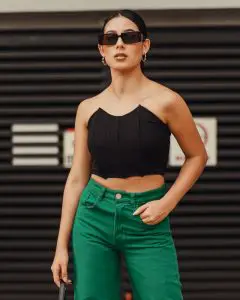Introduction:
Depop’s influence in the fashion industry is undeniable. Chances are you probably know someone who runs a Depop business, have purchased vintage ensembles from Depop, or you might even run a Depop business yourself. Depop is a peer-to-peer second-hand shopping app that allows its users to be their own boss and give its sellers full creative control of how they want to market their vintage finds.
As of May 2020, Depop has amassed 15 million registered users worldwide with 90% of its users being under the age 26. Since the creation of Depop, and with Gen Z’s romanticization of the ’90s and early 2000s, the 90’s aesthetic and Y2K(the year 2000) fashion trends have become more and more popular further creating a ripple effect of people increasingly purchasing their clothing from second-hand shops and thrift stores.
To help you navigate the post, here’s a breakdown of the article’s sections:
1. Promoting Sustainability
2. Bringing the Past into the Future
3. A New Way of Conducting Business
4. Influencing Fashion Trends
5. Conclusions
1. Promoting Sustainability
How is Depop sustainable? Depop recognizes the fact that we are currently living in a climate emergency with fast fashion making the crisis exponentially worse. Fashion all together is responsible for 10% of global carbon emissions and 20% of global wastewater. We are currently in the midst of a fashion crisis! With Gen Z being extremely environmentally conscious, Depop is the perfect avenue to turn to for today’s young shoppers that hope to make a difference. The Instagram-esque format of the app is typically brimming with an infinite parade of vintage and gently or moderately used clothing to purchase.
Previously loved fashion is often more suitable for the environment because instead of perpetuating the vicious cycle of throwing away and purchasing new clothes, users recycle items they’ve lost interest for by passing it on to someone who appreciates the pieces for all that they are. This extends a garment’s life as opposed to sentencing it to a premature death by tossing it in the trash and sending it off to get buried in a landfill. The trend of upcycling has been on the rise, but Depop has played a key role in this by providing an easy to use platform. Sustainability is more accessible than ever before, and since the social selling app’s feed resembles that of instagram, it brings a sense of familiarity to its audience in a new fun way. Practicing sustainability is now more universal.
The revolutionary brand has recognized we don’t have much time to fix the environmental damages that have been done. An end of the year goal for Depop is to become a climate-neutral company by addressing the fact that shipping can make up to 98% of a marketplace’s carbon footprint. For each transaction made on Depop, they will offset 100% of greenhouse gas emissions caused by shipping, by purchasing verified carbon credits.
2. Bringing The Past Into The Future
With the increase in young people shopping for clothing items that were popular 20-30 years ago there has been a rise in mixing vintage pieces and adding a twist of modernity to create funky ensembles. Notable ultra-niche aesthetics that have been born from such practices are “cottagecore”, “witchcore”, “dark academia” ,and “e-girl/e-boy” among many others. It seems to be a merging of different notable eras.
- What is cottagecore? Cottagecore is not only an aesthetic, it’s a movement and a way of life. According to Clever, it is characterized as “ a concept, it embraces a simpler, sustainable existence that is more harmonious with nature and aesthetically, it’s a nod to the traditional English countryside style, romantic and nostalgic”. A popular 90’s staple that helps bring to life this whimsical aesthetic is floral print dresses with ruffles. Popular cottagecore activities include leaving electronics behind and embracing a countryside lifestyle which includes baking bread (particularly sourdough), craft projects like knitting, finding refuge in the great outdoors, creating and maintaining a sustainable garden and having picnics in lush grasslands. Partaking in rural lifestyle activities in part is a reaction against capitalism and our growing time spent stuck in front of a screen, but also relevant to continuing interests in wellness and sustainability. The bigger picture of this aesthetic and way of life is the idea of practicing social consciousness.
- Witchcore incorporates some elements of cottagecore with a supernatural twist. Some popular 90’s occult films that have inspired many Depop sellers to hone in on this aesthetic are; The Craft, Adams Family, Practical Magic, and Witches of Eastwick (1987). Silk slip dresses and doc martens have made a major comeback in recent years and are highly associated with the witchcore aesthetic. Witchcore is a subculture linked to everything witchy. It is clothing as well as lifestyle practices and even home decor.The grunge craze in the ’90s has made its way over and has been given a modern rewrite to become a key component in this aesthetic. White collard shirts layered under velvet tops, as well as long dark floral maxi skirts. Fishnets have made a major comeback and are being layered under dresses. Also, you can’t mention grunge without acknowledging the importance of chokers in the official grunge look. The witchy queen herself Stevie Nicks has impacted this young generation with her enchanting fashion sense. The ’70s are being incorporated with iconic pieces such as bell-bottom pantsuits. Depop sellers have created many versions of witchcore and all include layering to create funky modern looks with elements of fashion’s past. Elements of layering include intricate black lace, flowy capes and bell-sleeve dresses, necklaces, rings and the use of gemstones and energizing crystals.However, witchcore is more than just the clothes you wear, it is a lifestyle with feminist origins and has become a community for some. Many young women identify with the witchcore aesthetic and witchy lifestyle because it aligns with feminist values such as female empowerment, autonomy over our (women’s) own bodies, and living life by your own standards and rules. Activities that are commonly partaken in by people in this community are tarot readings, practices of Feng Shui, and even practising spellwork for protection or manifestation.
- Dark academia is an aesthetic and a subculture embracing the nostalgia of early to mid-20th century life in academia. The dark academia inspiration stems from Oxford University and Ivy League Universities in the United States. It’s a romanticization of art, philosophy and the yearning for knowledge. There is also an emphasis on the prep-school experience, like what we see on television shows like Queens Gambit, Peaky Blinders and movies like Dead Poets Society. I know you’re wondering what is it that “makes it so dark?”. This aesthetic appears to give a moody and mysterious vibe with its dark colour palette. You can effortlessly combine this aesthetic with a murder mystery, like in the blockbuster movie Kill Your Darlings (2013). Clothing items associated with the dark academia aesthetic are; blazers, cardigans, long coats, plaid skirts, knitted sweaters, oxford shoes, button-up shirts, turtle necks, and plaid skirts/ trousers. There is a very specific colour palette incorporated in this specific look; the colours include dark neutrals, black, brown, dark green and different shades of grey. Typical activities associated with dark academia life are; learning a dead language, sketching strangers on your daily commute, learning the piano and visiting art galleries or old cathedrals. Dark academia has the key values of intelligence, curiosity and existentialism among many others.
- E-girl/boy rewrites 90’s goth with a virtual modern twist. The term “e-girl, combines the two words “electronic” and “girl”. E-girl/boy fashion staples include mesh shirts, colourful hair clips such as butterfly hair clips from the ’90s, Sailor Moon skirts, bulky collars, facial piercings, and 2000’s-esque graphic crop tops; on e-boys you’ll notice long messy hair that has been dyed with pastel or neon colours, chains, and high-waisted pants, though it’s worth noting that to be an e-boy or an e-girl does not exclude from identifying as non-binary, it’s important to note that both styles transcend gender. Other popular clothing items for this fashion niche include black cargo pants, wallet chains, chunky black belts, oversized graphic tees, and short pleated skirts. A theme in the e-girl/boy community is flashes of anime, skate culture, cosplay and hello kitty. The most notable look for an e-girl/boy, will incorporate bold hair colours and distinct placements for the artificial hair colour to create bold patterns. The colours for hair include lime green, pink, or half-black, half-white hair, red and purple. These hair colours can oftentimes be seen combined to create a unique look, or a single colour will be used on a strip of hair for a bold statement. E-girls will almost always incorporate glamorous winged eyeliner with bold eye makeup looks that portray an almost cartoon-like version of themselves. An e-girls clothes are most-likely thrifted from Depop or other alternative shops.
3. A New Way of Conducting Business
In Depop, sellers have the freedom to curate their own shops and choose what niche fits them best based on their aesthetic, and artistic expertise. Modern technology has allowed historic craft-based industries to increase the capability for indie creators and individual sellers to offer an in store-like feel that each ‘shop’ curates, with the ability for relationships to grow between buyer and seller in what creates a much more authentic customer experience. With Depop’s peer-to-peer e-commerce platform where sellers and buyers have the space to interact and mingle creates meaningful exchanges and selling becomes a personal experience.
With seller profiles resembling those of Instagram influencers, sellers have the freedom to artistically curate their items and content feed to their niche, without the concern of mainstream fashion. The commonly used ‘verification badge’ on social media platforms is a tool Depop utilizes and helps encourage sellers to invest time and effort into shaping and perfecting their ‘shops’ image. An important aspect of Depop’s appeal is how the pieces being sold on the app are original and are scarce in quantity. This offers buyers a “one-of-a-kind” feeling, a rejection of the conformity that fast fashion represents.
4. Influencing Fashion Trends
Depop’s format reflects Generation Z’s sense of individualism that influencer culture has made popular. Sellers have been known to offer bundles to buyers inspired by their own style, which gives buyers a chance to be personally styled in ways they would have never attempted to do themselves. The well known Depop seller iGirl offers her cult-like following a chance to try out different themed styles they may have missed when they originally were the pinnacle in fashion, in which most of the time it was before they were even born. Depop has a cool factor that young people flock to for style inspiration and is seen as a tool to rebrand and reinvent themselves. Today’s youth has more influence on the fashion world than ever before, these young visionaries are the ones setting the new trends and rewriting the rules. Vintage styles have become more appealing in the sense that it gives buyers an added layer of individuality and a cooler edge compared to the homogenous landscape of fast fashion. Depop’s utilization of second-hand fashion played a major role in propelling a less stigmatized view and a more socially accepted view on second-hand fashion.
Conclusions
Depop is leading the industry in a magnitude of ways. Depop is bringing more power to the people, which is a big social concern among Gen Z. The fashion world is now a consumer-led industry with consumers starting the trends and the rest of the industry following suit to meet the demand of distinctive aesthetic niches created by thrifting one-of-a-kind vintage pieces. I have a feeling those game-changing practices are here to stay and Depop will continue to carve out new landscapes in the fashion world.







